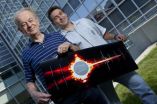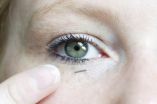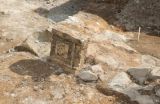(Press-News.org) Cambridge, Mass. – September 7, 2012 - An international, Harvard-led team of researchers have demonstrated a new type of light beam that propagates without spreading outwards, remaining very narrow and controlled along an unprecedented distance. This "needle beam," as the team calls it, could greatly reduce signal loss for on-chip optical systems and may eventually assist the development of a more powerful class of microprocessors.
Based at the Harvard School of Engineering and Applied Sciences (SEAS) and the Laboratoire Interdisciplinaire Carnot de Bourgogne, CNRS, in France, the applied physicists both characterized and created this needle beam, which travels efficiently at the interface of gold and air. Their findings were published online August 31 in the journal Physical Review Letters.
The needle beam arises from a special class of quasiparticles called surface plasmons, which travel in tight confinement with a metal surface. The metallic stripes that carry these surface plasmons have the potential to replace standard copper electrical interconnects in microprocessors, enabling ultrafast on-chip communications.
One of the fundamental problems that has so far hindered the development of such optical interconnects is the fact that all waves naturally spread laterally during propagation, a phenomenon known as diffraction. This reduces the portion of the signal that can actually be detected.
"We have made a major step toward solving this problem by discovering and experimentally confirming the existence of a previously overlooked solution of Maxwell's equations that govern all light phenomena," says principal investigator Federico Capasso, Robert L. Wallace Professor of Applied Physics and Vinton Hayes Senior Research Fellow in Electrical Engineering at SEAS. "The solution is a highly localized surface plasmon wave that propagates for a long distance, approximately 80 microns in our experiments, in a straight line without any diffraction."
The so-called needle beam, the technical term for which is a cosine-Gauss plasmon beam, propagates in tight confinement with a nanostructured metal surface. Lead author Jiao Lin, a visiting postdoctoral fellow at SEAS from the Singapore Institute of Manufacturing and Technology, and coauthor Patrice Genevet, a research associate in Capasso's group, found an ingenious way to demonstrate the theorized phenomenon. They sculpted two sets of grooves into a gold film that was plated onto the surface of a glass sheet. These tiny grooves intersect at an angle to form a metallic grating. When illuminated by a laser, the device launches two tilted, plane surface waves which interfere constructively to create the non-diffracting beam.
"Our French colleagues did a beautiful experiment, using an ultrahigh-resolution microscope to image the needle-shaped beam propagating for a long distance across the gold surface," says Genevet.
Capasso's team hopes the finding will assist the development of more energy-efficient and powerful microprocessors.
INFORMATION:
Coauthors at CNRS included Jean Dellinger, Benoit Cluzel, and group leader Frederique de Fornel.
This work was partially supported by the U.S. Air Force Office of Scientific Research. The researchers also benefited individually from the support of the Agency for Science, Technology, and Research, Singapore, and the Robert A. Welch Foundation. Devices were fabricated at Harvard's Center for Nanoscale Systems, a member of the National Nanotechnology Infrastructure Network, funded by the National Science Foundation.
Additional images, including a comparison of the simulated result and the experimental result, are available to the media upon request.
Needle beam could eliminate signal loss in on-chip optics
Harvard researchers create a light wave that propagates without spreading
2012-09-07
ELSE PRESS RELEASES FROM THIS DATE:
The birdy smell of a compatible partner
2012-09-07
New evidence shows that birds may choose their mate with the help of smell. They prefer a dissimilar mate because this gives their young a more efficient immune system. This has been shown in a new study by researchers from Lund University in Sweden, in a Swedish-French collaboration.
Humans and many animals can choose a suitable mate by smell. Choosing a mate with the right smell can give the offspring an efficient immune system. This is because each individual's smell can be said to reflect information on the individual's genes. By finding the mate whose genes best ...
Measuring glucose without needle pricks
2012-09-07
Sticking yourself in the finger day after day: For many diabetics, this means of checking blood glucose is an everyday part of life. Especially for patients with Type-1 diabetes, who always have to keep a close eye on their levels, since their bodies are incapable of producing the insulin to break down the glucose in the blood. Several times a day, they have to place a tiny drop of blood on a test strip. It is the only way they can ascertain the blood glucose value, so they can inject the correct amount of insulin needed. And this pricking is not only a burdensome: it may ...
Unemployment causes more mental health problems among Somalis in London than in Minneapolis
2012-09-07
Somali immigrants to the UK and USA appear to integrate better and have fewer mental health problems if they are allowed to work and they receive practical support during the first few years of their time in the new country, according to a study led by researchers at Queen Mary, University of London (UK) and published in BioMed Central Public Health today (Friday). [1]
The study used a survey and focus groups to investigate the experiences of Somalis living in London (UK) and Minneapolis (USA). After adjusting for various factors such as age, sex and marital status, the ...
Archaeologists uncover 'lost garden' in quest for Richard III
2012-09-07
Archaeologists from the University of Leicester who are leading the search for the lost grave of King Richard III announced today that they have made a new advance in their quest.
They have uncovered evidence of the lost garden of Robert Herrick – where, historically, it is recorded there was a memorial to Richard III.
Now the 'time tomb team' as they have become to be known has discovered paving stones which they believe belong to the garden.
The University of Leicester is leading the archaeological search for the burial place of King Richard III with Leicester City ...
Premier global health journal, The Lancet, releases series on universal health coverage
2012-09-07
Washington D.C., September 7, 2012 – Every year 100 million people are pushed into poverty because they have to pay for health services directly. With support from the Rockefeller Foundation, Results for Development Institute has partnered with the world's premier global health journal, The Lancet, on a special collection of papers exploring the social, political, and economic issues around the global movement towards universal health coverage (UHC) – defined by the World Health Organization as everyone in a population having access to appropriate, promotive, preventive, ...
Antibiotic therapy improves moderate exacerbations of mild-to-moderate COPD
2012-09-07
Antibiotic treatment with amoxicillin/clavulanate improves moderate exacerbations in patients with mild-to-moderate chronic obstructive pulmonary disease (COPD) and significantly prolongs the time between exacerbations, according to a new study from researchers in Spain.
"The existing evidence for antibiotic therapy in non-severe exacerbations of COPD is weak," said lead author Carl Llor, MD, PhD of the University Rovira i Virgili in Tarragona, Spain. "The results of our multicenter, randomized, double-blind, placebo-controlled trial show that antibiotic treatment is ...
Towards computing with water droplets -- superhydrophobic droplet logic
2012-09-07
Researchers in Aalto University have developed a new concept for computing, using water droplets as bits of digital information. This was enabled by the discovery that upon collision with each other on a highly water-repellent surface, two water droplets rebound like billiard balls.
In the work, published in the journal Advanced Materials, the researchers experimentally determined the conditions for rebounding of water droplets moving on superhydrophobic surfaces. In the study, a copper surface coated with silver and chemically modified with a fluorinated compound was ...
Istanbul -- The earthquake risk of a megacity
2012-09-07
Today the drilling starts for a seismic monitoring network on the Marmara Sea near Istanbul. Specially designed seismic sensors in eight boreholes on the outskirts of Istanbul and around the eastern Marmara Sea will monitor the seismic activity of the region with high precision. In each of the respective 300 meter deep holes several borehole seismometers will be permanently installed at various depths. These detect even barely perceptible earthquakes with very small magnitudes at a high resolution and can thus provide information about the earthquake rupture processes associated ...
University of Toronto scientists cast doubt on renowned uncertainty principle
2012-09-07
TORONTO, ON – Werner Heisenberg's uncertainty principle, formulated by the theoretical physicist in 1927, is one of the cornerstones of quantum mechanics. In its most familiar form, it says that it is impossible to measure anything without disturbing it. For instance, any attempt to measure a particle's position must randomly change its speed.
The principle has bedeviled quantum physicists for nearly a century, until recently, when researchers at the University of Toronto demonstrated the ability to directly measure the disturbance and confirm that Heisenberg was too ...
Ancient, bottom-dwelling critter proves: Newer isn't always better
2012-09-07
BUFFALO, N.Y. -- Tiny sea creatures called rhabdopleurids reside on the ocean floor, building homes of collagen on the shells of dead clams. Rhabdopleurid colonies are small, and the critters are by no means the dominant animals in their ecosystem.
But they have lived this way -- and survived -- for more than 500 million years. And in doing so, they have outlasted more elaborate species that also descended from a common ancestor, according to a new study in the journal Lethaia.
Though rhabdopleurids' age and modern existence are well-documented, the paper breaks new ground ...
LAST 30 PRESS RELEASES:
Making lighter work of calculating fluid and heat flow
Normalizing blood sugar can halve heart attack risk
Lowering blood sugar cuts heart attack risk in people with prediabetes
Study links genetic variants to risk of blinding eye disease in premature infants
Non-opioid ‘pain sponge’ therapy halts cartilage degeneration and relieves chronic pain
AI can pick up cultural values by mimicking how kids learn
China’s ecological redlines offer fast track to 30 x 30 global conservation goal
Invisible indoor threats: emerging household contaminants and their growing risks to human health
Adding antibody treatment to chemo boosts outcomes for children with rare cancer
Germline pathogenic variants among women without a history of breast cancer
Tanning beds triple melanoma risk, potentially causing broad DNA damage
Unique bond identified as key to viral infection speed
Indoor tanning makes youthful skin much older on a genetic level
Mouse model sheds new light on the causes and potential solutions to human GI problems linked to muscular dystrophy
The Journal of Nuclear Medicine ahead-of-print tip sheet: December 12, 2025
Smarter tools for peering into the microscopic world
Applications open for funding to conduct research in the Kinsey Institute archives
Global measure underestimates the severity of food insecurity
Child survivors of critical illness are missing out on timely follow up care
Risk-based vs annual breast cancer screening / the WISDOM randomized clinical trial
University of Toronto launches Electric Vehicle Innovation Ontario to accelerate advanced EV technologies and build Canada’s innovation advantage
Early relapse predicts poor outcomes in aggressive blood cancer
American College of Lifestyle Medicine applauds two CMS models aligned with lifestyle medicine practice and reimbursement
Clinical trial finds cannabis use not a barrier to quitting nicotine vaping
Supplemental nutrition assistance program policies and food insecurity
Switching immune cells to “night mode” could limit damage after a heart attack, study suggests
URI-based Global RIghts Project report spotlights continued troubling trends in worldwide inhumane treatment
Neutrophils are less aggressive at night, explaining why nighttime heart attacks cause less damage than daytime events
Menopausal hormone therapy may not pose breast cancer risk for women with BRCA mutations
Mobile health tool may improve quality of life for adolescent and young adult breast cancer survivors
[Press-News.org] Needle beam could eliminate signal loss in on-chip opticsHarvard researchers create a light wave that propagates without spreading




